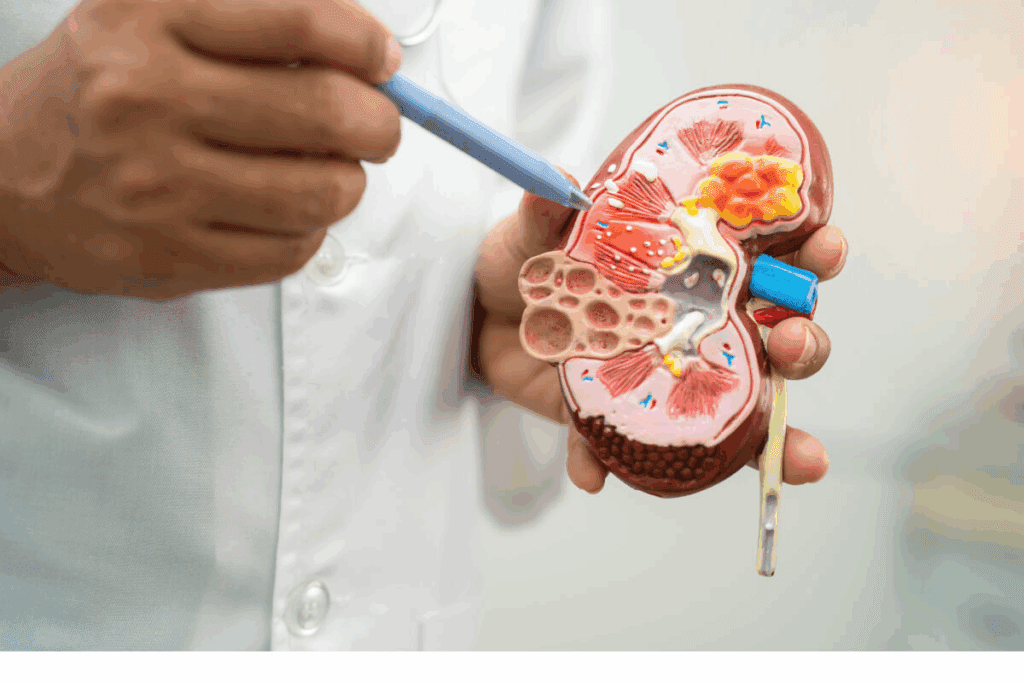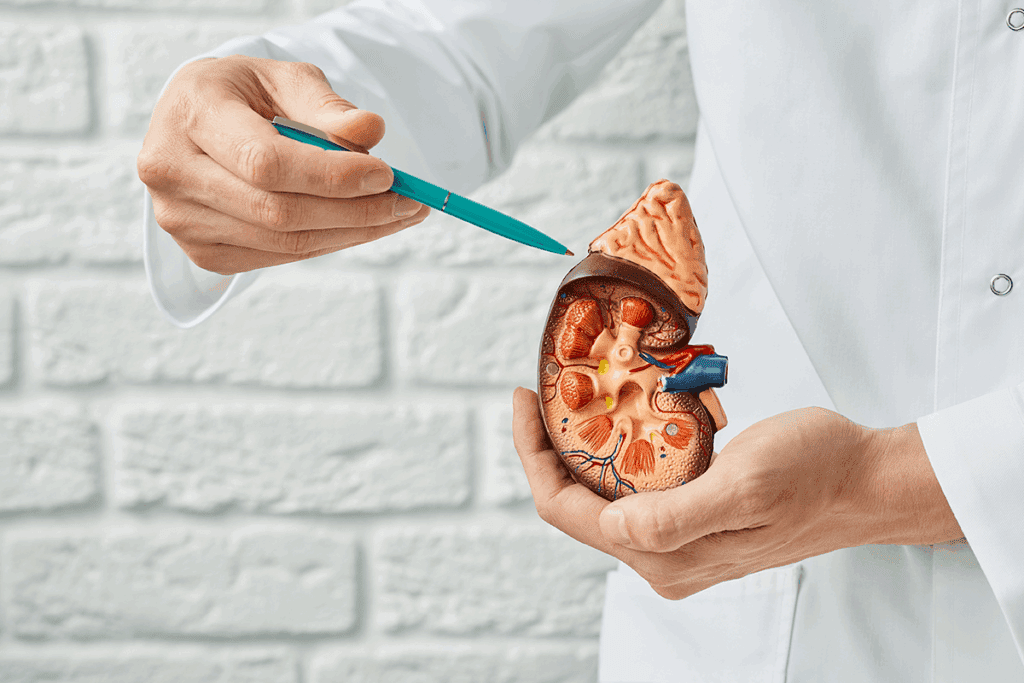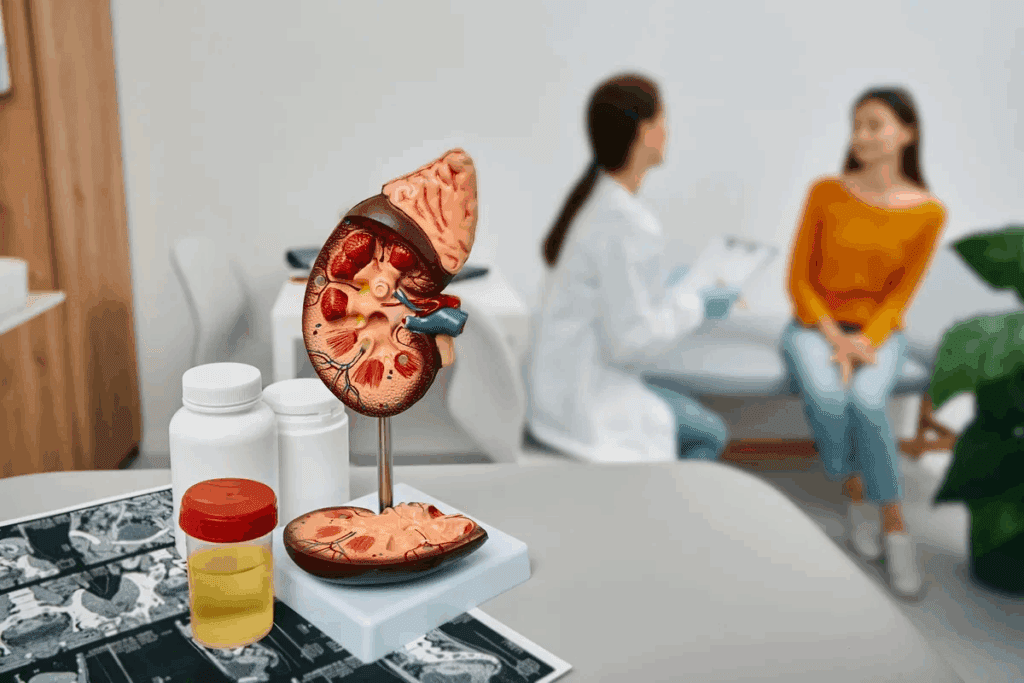
Calcium oxalate kidney stones are a big health issue, affecting millions globally. We know that stopping these stones needs a plan made just for you, not a one-size-fits-all diet. At Liv Hospital, we use our international knowledge and focus on you to help you avoid these stones. Learn the specific dietary and lifestyle changes required to prevent calcium oxalate kidney stones, the most common type of kidney stone.
About 10% of people worldwide will get kidney stones at some point, with many facing them again. By learning how calcium oxalate crystals form and using proven ways to stop them, we can cut down on how often they happen. This makes life better for those dealing with them.

To prevent calcium oxalate kidney stones, knowing what they are and how they form is key. We’ll look into the details of these stones and how they come to be.
Calcium oxalate kidney stones are hard deposits made of calcium and oxalate. They form inside the kidneys. These stones are the most common type and can be influenced by diet, how much you drink, and genetics.
Calcium oxalate stones form when urine has too much calcium and oxalate. This is called supersaturation. It can happen if you don’t drink enough, eat too much oxalate or calcium, or have certain health conditions.
When urine is concentrated, the risk of stone formation goes up. This is because there are more minerals that can crystallize and form stones. Normally, substances like citrate and magnesium in the urine help prevent this. But if there’s not enough of these substances, the risk of stone formation increases.
Calcium oxalate stones can be divided into two types: monohydrate and dihydrate stones.
| Characteristics | Monohydrate Stones | Dihydrate Stones |
| Crystalline Structure | More common and typically denser | Less common, often associated with higher urine calcium levels |
| Appearance | Usually have a characteristic “envelope” or “dumbbell” shape under microscopic examination | Typically have a bipyramidal or “envelope” shape |
| Risk Factors | Associated with hyperoxaluria and low urine volume | Often linked to high calcium intake or hypercalciuria |
Knowing the differences between these stone types can help in creating prevention plans that fit an individual’s needs.

Kidney stones are becoming more common worldwide. About 10% of people will get kidney stone disease at some point in their lives. This condition affects not just individuals but also healthcare systems and economies.
The risk of getting kidney stones varies by region and population. Men are more likely to get kidney stones than women. The risk peaks between 30 and 60 years old. Diet, hydration, and genetics play a role in who gets kidney stones.
Kidney stone disease often comes back. About 30% to 50% of people will get another stone within 5 to 10 years without prevention. This can lead to chronic kidney disease and other serious issues, making prevention and management key.
Kidney stone disease is costly for healthcare systems. It also affects patients’ quality of life, causing pain and anxiety. The economic burden is increased by lost productivity due to the condition’s severity.
| Aspect | Impact | Statistics |
| Global Prevalence | Affects a significant portion of the global population | Approximately 10% |
| Recurrence Rate | High risk of recurrence without preventive measures | 30% to 50% within 5 to 10 years |
| Economic Burden | Significant costs for diagnosis, treatment, and management | Substantial economic impact on healthcare systems |
| Quality of Life | Pain, discomfort, and anxiety for patients | Significant impact on daily life and productivity |
It’s important to know why calcium oxalate crystals in urine happen and how to find them. These crystals can mean you might get kidney stones. Finding them early and acting fast is key.
Supersaturation happens when urine has too much of certain substances. This can lead to crystals forming. For calcium oxalate crystals, it’s often because of too much calcium or oxalate in the urine. Dehydration, what we eat, and some health issues can cause this.
To stop supersaturation, drink lots of water. This helps dilute the urine and lowers the chance of stones forming.
The growth of calcium oxalate crystals depends on inhibitors and promoters. Inhibitors like citrate, magnesium, and proteins stop crystals from forming. But, promoters like high urine pH, some medicines, and too much calcium or oxalate help crystals grow.
Urinalysis can find calcium oxalate crystals in urine. A 24-hour urine test is very helpful. It shows what’s in the urine and if you might get stones.
Urinalysis not only finds crystals but also other things that might cause stones. This includes pH levels and the amount of different substances.
Black kidney stones are a type of calcium oxalate stone. They form under certain conditions. Knowing about black kidney stones can help prevent and treat them.
Black kidney stones show how complex kidney stones can be. They need a plan that fits each person’s risk and urine type.
Knowing your personal risk factors can help prevent kidney stones. Understanding these factors lets you take steps to avoid stones.
Genetics are key in kidney stone formation. If your family has a history of stones, you might get them too. Studies show a link between family history and stone risk.
Certain health issues raise your stone risk. These include:
These conditions can change your urine, making stones more likely.
Some drugs can up your stone risk. These include:
| Medication | Risk Factor |
| Calcium supplements | Too much calcium |
| Vitamin C supplements | Turns to oxalate |
| Certain antibiotics | Changes gut bacteria |
Talk to your doctor about your meds to know the risks.
Where you live and your environment can affect stone risk. Hot, dry places and dehydration are risks. Also, eating too much animal protein, sodium, and sugar can lead to stones.
Knowing these risks helps you lower your stone chance. Take steps to avoid them.
Understanding and managing kidney stone disease requires a detailed approach. Healthcare providers use various tools and techniques to diagnose and treat kidney stones effectively.
A 24-hour urine collection test is key in assessing stone formation risk. It measures calcium, oxalate, and citrate levels. These are vital for identifying the causes of kidney stones.
This test involves collecting urine over 24 hours in a special container. The lab analysis provides insights into stone formation factors. This helps healthcare providers create prevention plans.
Blood tests are essential in evaluating kidney stone disease. They measure calcium and phosphate levels, which can lead to stone formation.
Metabolic evaluations uncover underlying conditions like hyperparathyroidism. This knowledge helps healthcare providers develop effective treatment plans.
Imaging studies are vital for diagnosing kidney stones. Techniques like CT scans, X-rays, and ultrasounds help identify stone location, size, and composition.
These studies guide healthcare providers in choosing the best treatment. This could be surgery or conservative management.
Stone analysis is a critical step in managing kidney stone disease. It helps determine the stone’s composition and underlying cause. This information is key for prevention strategies.
The most common stone type is calcium oxalate monohydrate. Knowing its composition is essential for effective prevention.
The table below summarizes the main diagnostic approaches for kidney stone disease:
| Diagnostic Approach | Description | Key Findings |
| 24-Hour Urine Collection | Measures various parameters, including calcium, oxalate, and citrate levels | Identifies risk factors for stone formation |
| Blood Tests | Measures metabolic factors, including calcium and phosphate levels | Identifies underlying metabolic conditions |
| Imaging Studies | Identifies location, size, and composition of kidney stones | Guides treatment decisions |
| Stone Analysis | Determines composition of kidney stone | Informs prevention strategies |
Keeping well-hydrated is key to preventing kidney stones. We’ll show you how to drink enough water. Drinking water helps dilute substances that can form stones, making it harder for them to form.
Try to make at least 2.1 quarts (2 liters) of urine each day. This can lower your risk of getting kidney stones. You can do this by drinking lots of fluids all day.
Tips for Meeting Your Fluid Intake Targets:
Drinking fluids at regular times helps keep you hydrated. It’s key to drink more when you’re active or in the heat.
Water is the top choice for staying hydrated. But, other drinks can also help. Choose drinks that are low in sugar, salt, and oxalate.
Recommended Beverages:
Check your urine color to see if you’re drinking enough water. It should be pale yellow or clear. If it’s dark yellow or amber, you need to drink more.
By following these tips, you can lower your risk of kidney stones. Remember, prevention is important. Staying hydrated is a simple and effective way to keep your kidneys healthy.
Calcium oxalate kidney stones can be prevented with the right diet. Knowing how nutrients affect stone formation helps us make better choices.
Enough calcium is key to avoiding calcium oxalate stones. It might seem odd, but calcium binds to oxalate in the gut, reducing its absorption and excretion in urine. Research shows that those with enough calcium are less likely to get stones.
A study in the New England Journal of Medicine found men with high calcium intake had a 34% lower risk of stones than those with less calcium.
While calcium is important, controlling dietary oxalate is also vital. Oxalate is in foods like spinach, beets, and nuts. Eating less of these foods can help prevent stones.
You don’t have to cut out these foods completely. Just be careful with how much you eat.
Eating too much animal protein can raise the risk of stones. It increases calcium, oxalate, and uric acid in urine. High sodium intake also raises calcium excretion. And too much sugar can increase stone risk.
“A high intake of animal protein, sodium, and sugar can significantly increase the risk of developing kidney stones.”
A statement from a leading nephrology journal
The DASH diet is rich in fruits, vegetables, and whole grains. It helps prevent kidney stones and is good for heart health too.
By following the DASH diet and watching your intake of calcium, oxalate, protein, sodium, and sugar, you can lower your risk of calcium oxalate kidney stones.
Medical treatments and supplements are key to stopping calcium oxalate kidney stones. They are vital for those at high risk or who have had stones before. These steps can greatly lower the chance of more stones.
Citrate supplements are a big help in stopping calcium oxalate kidney stones. They increase the amount of citrate in urine. Citrate binds to calcium, making it less likely to form stones. This helps prevent new stones and can even shrink existing ones.
Research shows citrate supplements can cut down on stone return in people at risk. Always talk to a doctor to find the right dose and type of citrate supplement for you.
Magnesium is important in preventing kidney stones. It binds to oxalate in urine, reducing the chance of calcium oxalate stones. It also makes calcium oxalate more soluble, lowering stone risk.
Studies suggest magnesium supplements can help those at risk of kidney stones. But, always check with a doctor before starting magnesium supplements to avoid any issues.
For those at high risk of kidney stones, prescription meds might be needed. These meds can tackle specific issues that lead to stones.
Some supplements can increase kidney stone risk. Knowing which ones to avoid is important.
| Supplement/Medication | Potential Risk |
| High-dose vitamin C | Increases oxalate production |
| Calcium supplements (if not necessary) | Increases calcium stone risk |
| Certain antibiotics | Changes gut flora, may increase oxalate absorption |
Always talk to a doctor before starting new supplements or meds. They can help weigh the risks and benefits for your specific situation.
To prevent calcium oxalate kidney stones, you need a plan that includes diet changes, staying hydrated, and sometimes medical help. Knowing what causes these stones helps you avoid them. This way, you can lower your chance of getting this painful condition.
Studies show that a plan made just for you is best. Work with doctors to create a prevention plan that fits your needs. This will help you control calcium oxalate crystals in your urine and lower your stone risk.
With a plan made just for you, you can lower your risk of calcium oxalate kidney stones. It’s important to take care of your kidneys. Talk to doctors to make a plan that’s right for you to avoid kidney stones.
Calcium oxalate kidney stones are made of calcium and oxalate. Oxalate is found in many foods. They form when there’s too much of these in the urine.
Stones form when urine has too much calcium and oxalate. This lets crystals form and stick together to make a stone.
Monohydrate stones are denser and harder to break up. Dihydrate stones are less dense and easier to break. Knowing the type helps choose the best treatment.
Yes, diet affects stone formation. Eating too much oxalate, sodium, and animal protein increases risk. But enough calcium can help prevent stones.
To prevent stones, drink plenty of water, control oxalate and calcium intake, and limit sodium and animal protein. Taking citrate or magnesium supplements may also help.
Hydration is key to preventing stones. It dilutes urine, reducing stone-forming substances. Drinking enough water keeps urine pale yellow.
Yes, conditions like hyperparathyroidism, renal tubular acidosis, and inflammatory bowel disease raise stone risk.
Yes, some medications like diuretics, calcium supplements, and antibiotics can increase stone risk by changing urine balance.
Urinalysis detects calcium oxalate crystals. It involves examining a urine sample under a microscope to find crystals.
Black stones may signal a complex metabolic issue. They often require a specific prevention and treatment plan.
Risk assessment involves looking at genetic predispositions, medical history, diet, and environment. A healthcare professional can help identify risk factors.
Tests include 24-hour urine collection, blood tests, imaging like CT scans, and stone analysis. These help understand the stone and guide prevention.
Yes, supplements like citrate and magnesium can prevent stones. They reduce stone-forming substances in urine or stop crystal formation.
National Center for Biotechnology Information. (2025). How to Prevent Calcium Oxalate Kidney Stones Managing. Retrieved from https://www.ncbi.nlm.nih.gov/pmc/articles/PMC1455427/
Subscribe to our e-newsletter to stay informed about the latest innovations in the world of health and exclusive offers!
WhatsApp us